| Thirty years ago, Iran experienced
a popular revolution to put an end to 2500 years of monarchy and replace
it with an Islamic government. The leader of the revolution, Ayatollah
Khomeini, marked the establishment of a two-tier state, receiving
its legitimacy from the two sources of divinity and public support.
He offered the name of ‘Islamic Republic’ for such a state,
which was endorsed overwhelmingly by a national referendum in 1979.
The idea of having a theo-democracy was put on trial. It was scrutinised
and challenged both conceptually and in practice by the Islamists
and non-Islamists alike.
The main arguments though came from within, from
the religious elites, who by decree were entitled to interpretation
of the religious rulings. Questions were predominantly asked about
the compatibility of the two concepts of religiosity and democracy.
But beyond that, some, who had already recognised this coexistence,
began to ask the inherent question as to which element should take
precedence, ‘Islamism’ or ‘republicanism’.
Without undermining the totality of the regime, they
argued that the survival of the Islamic state depends on public accountability,
which should not be compromised under any circumstances. This reading
did not quite reflect the idea of marriage between the two concepts
envisaged by Ayatollah Khomeini. These discourses, although fierce
in nature, did not pose much of a threat to the fundamentality of
the Islamic state, particularly because the charismatic leader and
the founding father of the revolution, Ayatollah Khomeini, maintained,
as the main interpreter of the theory of Islamic governance and the
prime arbiter, a balance between rival elites and thinkers.
Confident enough of being able to control embryonic
divergences, he also gave his blessing to a degree of pluralism, whereby
some less senior clerics formed a new factional entity by the name
of the ‘Association of Combatant Clerics’ in 1988 in opposition
to an older clerical establishment, i.e. the ‘Society of Combatant
Clergy’. It is interesting to see this newly established faction
is now the chief promoter of ‘republicanism’ and the main
challenger to the government.
The Islamic government enjoyed a period of uniformity
during the Iran-Iraq war. Any in-house challenge among the religious
and political elites had to wait until the country came back on its
feet. It took a few years before the pro-reform ideas gained momentum
and dominated Iran’s political arena.
The year 1997 witnessed an overwhelming victory for
Mohammad Khatami in the presidential election, |
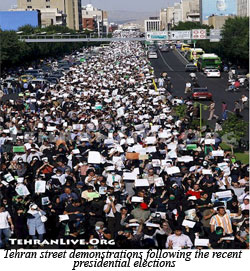
a more moderate cleric, an advocate of civil society,
freedom of speech and the rule of law, who remained in power for eight
years until being replaced by ‘principlist’ (a person
or group act based on tenets of Islam and values of the revolution),
Mahmoud Ahmadinejad.
Khatami encountered enormous difficulties in implementing
his reformist policies as he lacked structural power. However, the
reformist faction achieved a hegemonic status. The country became
more politically open and tolerant. Many political parties were formed
and numerous newspapers were given licence to print. This provided
the country with a foundation for a novel political factionalism,
an unprecedented phenomenon that was given an opportunity to grow
with an incredible speed, at times impossible to control and now challenging
in nature.
Although Iran’s democratic movement has a fairly
long history, going back to the Constitutional Revolution in 1906,
its experience of factionalism is rather young, rudimentary and non-institutionalised,
hence fragile in nature. A few camps formed around some political
figures; the reformists gathering around former president Mohammad
Khatami, the pragmatists embracing former president Akbar Hashemi
Rafsanjani, and last but certainly not least, the principlists encircled
the incumbent president Mahmoud Ahmadinejad.
But it is not as clear cut as it looks. There are
many other offshoots and subdivisions in the form of parties and factions,
aligning with one of the camps, but at the same time having extraordinary
disparities, a fact that has made the process of political participation
so ambivalent. As a vivid example, in recent elections both the reformists
and principlists failed to introduce a single candidate to represent
their factions, and effectively Mehdi Karroubi, a reformist cleric
candidate from the Etimad Melli (National Trust party), chose not
to withdraw in favour of Mir Hossein Mousavi, |
a clearly more
popular reformist candidate. Similarly, the principlist Society of
Combatant Clerics did not reach a majority to nominate Ahmadinejad
as their front runner.
Moreover, factionalism in Iran is characterised by
and large by a great degree of fluidity, the result of which is frequent
movement of the cardinal members across the political spectrum, or
even from one faction to another. A prime example is the former head
of the Revolutionary Guard Corps, Mohsen Rezaei, a principlist with
some reformist aspirations, who challenged Mahamoud Ahmadinejad, the
other principlist candidate.
The candidacy of Mir Hossein Mousavi, as the main
challenger to Ahamadinejad, was also enveloped from the outset by
uncertainty. Having undisputed revolutionary credentials, he could
easily be placed in the principlist camp. However, he decided to stand
for the presidency as an individual rather than a reformist candidate,
but sought to advocate ‘reform through principles’ and
promote righteous but forgotten revolutionary values. Such uncertainties
on the part of the candidates were undoubtedly counterproductive and
confusing when it came to vote winning.
The origins of the presidential election crisis were
not limited to factional uncertainty and divisions. They were also
rooted in the rapid growth of the youth generation, which is more
exposed to the outside world through modern means of communication.
Many of this generation have no personal recollection of the revolution
or the war with Iraq and seek no political confrontation with the
establishment. However, they are in favour of some changes to achieve
more citizenry rights. Ironically, the government’s progressive
modernising policies and advocacy for technological advancement should
have helped attract such demands by the youth, but at the same time
failed to appropriately process and meet them.
To put this into perspective, the recent developments
are testimony that Iranian society is maturing. So are its elites,
and many of the recent difficulties are part of the process of democratic
maturation. These difficulties will only be overcome if proper policies
and mechanisms are established to restore trust within the society,
something that seems utterly vital for the Islamic government.
|


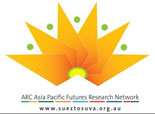
.jpg)

.jpg) In
an
In
an .jpg)
 Economically,
I think Australia will continue to be well-placed to both benefit from
and contribute to East Asia’s economic dynamism, and in the case
of Japan, South Korea, etc, its economic and demographic maturation.
Hence, Australia’s economic integration with East Asia should
continue full speed ahead and could even accelerate if East Asia’s
export-oriented economies shift towards more domestic consumption.
Economically,
I think Australia will continue to be well-placed to both benefit from
and contribute to East Asia’s economic dynamism, and in the case
of Japan, South Korea, etc, its economic and demographic maturation.
Hence, Australia’s economic integration with East Asia should
continue full speed ahead and could even accelerate if East Asia’s
export-oriented economies shift towards more domestic consumption. 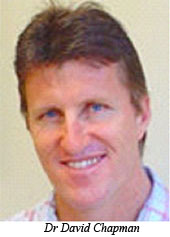 How did your interest in Japan start?
How did your interest in Japan start?.jpg)
.jpg) What
has been the team’s most significant achievement?
What
has been the team’s most significant achievement? .jpg) From
enormous temple complexes to the profusion of decorative detail on every
available surface, the sheer diversity, creativeness and scale of the
temples and art of Angkor is staggering and of world-wide renown. Yet,
says
From
enormous temple complexes to the profusion of decorative detail on every
available surface, the sheer diversity, creativeness and scale of the
temples and art of Angkor is staggering and of world-wide renown. Yet,
says 
.jpg) Japan’s
political parties have had a poor record when it comes to representation
of women in the national assembly. PhD candidate
Japan’s
political parties have had a poor record when it comes to representation
of women in the national assembly. PhD candidate  Deepening
Democracy in Indonesia? Direct Elections for Local Leaders (Pilkada)
Deepening
Democracy in Indonesia? Direct Elections for Local Leaders (Pilkada) Famine
in North Korea. Markets, Aid, and Reform
Famine
in North Korea. Markets, Aid, and Reform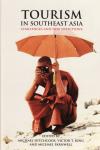 Tourism
in Southeast Asia. Challenges and New Directions
Tourism
in Southeast Asia. Challenges and New Directions 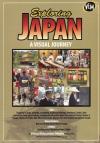 Exploring
Japan DVD. A Visual Journey
Exploring
Japan DVD. A Visual Journey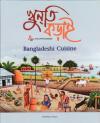 Bangladeshi
Cuisine
Bangladeshi
Cuisine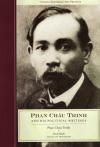 Phan
Chau Trinh and His Political Writings
Phan
Chau Trinh and His Political Writings